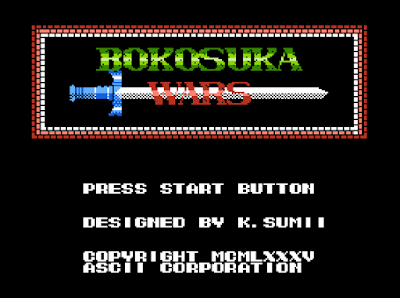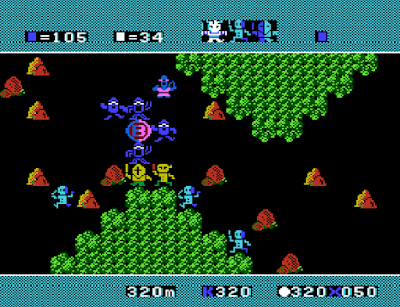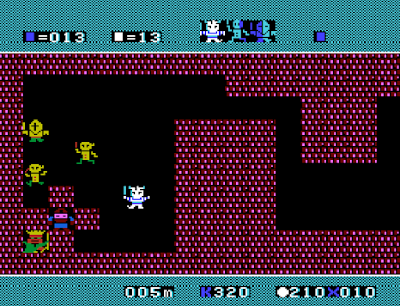From The CRPG Addict
Bokosuka Wars
Japan
ASCII (developer and publisher)
Released in 1983 for Sharp X1; 1984 for MSX and PC-88; 1985 for FM-7, PC-6001, PC-98, and NES
Date Started: 25 June 2019
Date Finished: 28 June 2019
Total Hours: 6
Difficulty: Hard (4/5), but would probably go down to 3/5 with more experience
Final Rating: (to come later)
Ranking at time of posting: (to come later)
Difficulty: Hard (4/5), but would probably go down to 3/5 with more experience
Final Rating: (to come later)
Ranking at time of posting: (to come later)
Well, I did it. I downloaded a Nintendo Entertainment System (NES) emulator–Nestopia–and I gave it a shot. It was easier than I expected. I was the thinking that the NES had a directional pad and an analog stick, but I guess that came with later consoles. The original NES controller is little more than a joystick (albeit one that made it harder to move diagonally) with two buttons. Easy to emulate, easy to remember.
Bokosuka Wars was on no one’s list of “must play” console RPGs, but I figured I’d give it a try anyway. It’s the earliest Japanese game on my list that had a western release and the earliest Japanese console game, beating several 1986 titles by a month or so. That it’s not actually an RPG by my definitions (no inventory) shouldn’t bother us too much. It was an easy step into this sub-genre.
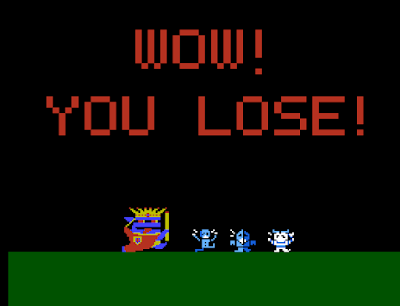 |
| A common screen, probably responsible for a lot of the hate the game receives. |
The game is an “afternoon RPG,” as any console must be until saving was possible. The setup is simple. You are King Suren, and your country has been overthrown by the evil King Ogreth of the Basam Empire (Ogreth is called “Dragonet” in the original Japanese versions). Ogreth has used his magic to turn all your knights and soldiers into rocks and trees and cacti. You embark on a mission to reclaim your throne. You start 600 meters to the east of King Ogreth’s throne room and slowly make your way left down the battlefield, fighting his forces as you go.
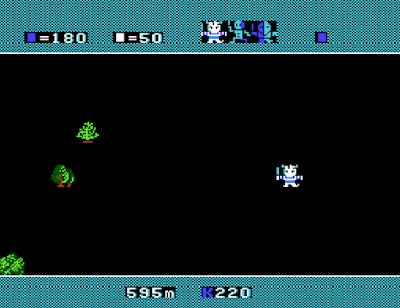 |
| The king starts alone, with 595 steps to his evil counterpart. |
You’re not alone in this endeavor. Along the way, you can rescue many of your knights and soldiers. (In the Japanese PC versions, Suren starts with many of his warriors already activated, but in the NES version, he starts alone.) Some are inanimate objects, but they’re revived if you touch them. Others are kept in stockades and must be rescued. Either way, you slowly build (and, just as fast, lose) an army. Eventually, if you survive, you reach Ogreth’s throne room and throw your remaining forces at him, including King Suren if necessary. If any of your units defeat Ogreth, you win the game.
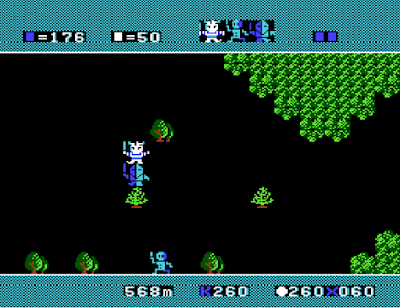 |
| King Suren turns a tree into a knight. |
The problem is that you can revive and rescue only 50 warriors (about 15 knights and 35 soldiers), and opposing you are 180 enemies: guards, mages, warriors, and pages. Some of them can be avoided, but most must be fought. Characters move around the battlefield in real-time, but this is in no way an “action RPG.” As frenzied as the game looks, no part of your success depends on your speed with the controller, particularly since enemies cannot attack you and combats are resolved statistically.
The game’s strategy lies in who fights what enemies, and in what circumstances. Your one huge advantage is that enemies can never initiate combat. They can block your way, but combat only begins when you decide to move Suren or one of his warriors to the enemy’s square. Thus, you can almost always choose who fights.
Combat is a probability test that pits your character’s power against the enemy’s, but with a heavy random component. If the die rolls go in your favor, you win; if not, you die. If the character fighting on your side was King Suren, and he dies, the game is over. Winning and losing is completely binary; there are no hit points in the game, so one character can’t “weaken” an enemy for the next character.
If you win, the winning unit gets an increase in power–sometimes substantial. For instance, soldiers start at a power of 30 and rise to 40 and 50 with their first two victories. But if they achieve a third victory, they change color and rise to 140. Knights do the same thing, with the progression going 150, 160, 170 and then jumping to 260 on the third victory.
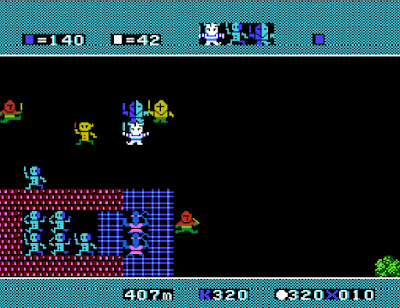 |
| Note that one of my knights and one soldier have “gone gold,” making them more powerful than their counterparts. A knight is needed to bust through the shield around the stockade. |
King Suren himself starts at 220 and maxes at 320; soldiers and knights max at 310. Throughout the game, you have to keep making the decision about whether to throw your more powerful figures into combat, thus risking them, or try to build up weaker units. There’s no easy answer. And occasionally even the most disproportionate combats can go wrong. I saw plenty of knights at 310 power killed by enemies at 10 power.
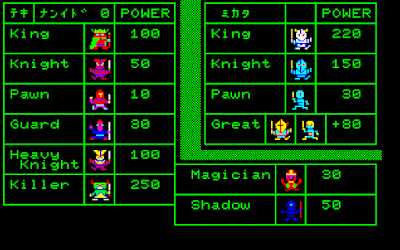 |
| Enemy and ally unit powers. This is from the Sharp X1 version. NES players had to read the manual. |
There are a few other tactical considerations. Regular soldiers (for some reason) knock enemy guards from 100 power to 10 power when they engage in combat. Knights are the only units that can break the walls of stockades, so you want to keep at least one around. You need soldiers to disarm traps (which don’t appear until after your first victory). Only the king can trigger special squares that remove the walls blocking “summoners,” who then summon a bunch of spirits (which don’t count against the enemy’s total) until you kill the summoners.
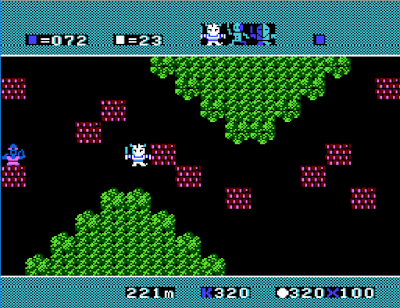 |
| Every once in a while, the king runs out of soldiers and stands alone. |
I suspect the game would be “easy” for those with a lot of patience. One key problem is the movement of your forces. By default everyone moves together when you press the directional pad; if they’re up against an obstacle, they just stay in place. You can toggle so that you’re only selecting one type of unit at a time (i.e., the king, all soldiers, or all knights), but it’s still tough to move them in unison, and I probably left more allies stuck on obstacles behind me than I lost in combat. This problem is the source of a lot of modern complaints about the game, I later found, but I think it added somewhat to the game’s strategy. When you have a lot of units in your army, you have to be careful about every move, noting who is going to end up in what square, and thus what units will find themselves in combat. A player who develops a huge army is handicapped by having to more carefully manage its movement. I can’t claim that I exactly “enjoyed” such a gameplay element, but that doesn’t make it inherently bad.
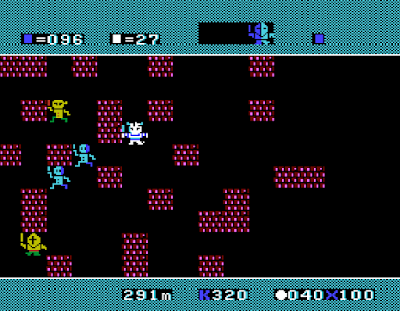 |
| Moving through terrain like this is easier when you only control one unit “type” at a time. |
You don’t have to fight every battle. In fact, there’s a good argument to be made in fighting as few as possible, thus reaching the end of the game with as many forces as possible. On the other hand, it helps if those forces have gained a lot of experience along the way, so you don’t want to eschew every combat. It’s a tough call.
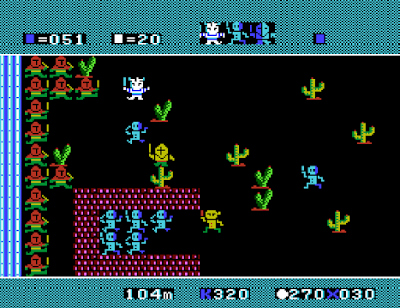 |
| Having broken a bunch of soldiers out of a stockade, now approaching a phalanx of guards. To get the soldiers out of their building, I’m going to have to move everybody back and up a few spaces. |
You eventually reach a point where you have to thread a narrow hallway to get to the throne room, which features a number of unavoidable battles with “killers” with 250 power. Even though you might have more than 300 power at this point, the killers seem to win more than half the time. The same is true for King Ogreth himself, who only has 250 power but seems to beat 300+-power allies at least three-quarters of the time. So whether you win or lose upon reaching the end is largely a matter of whether you have enough allies to overwhelm the probabilities of losing individual combats. You definitely don’t want it to come down to King Ogreth vs. King Suren.
A good opening strategy is to have Suren fight all the combats until he gets to his maximum power of 320. If he’s going to die, better it happens in the opening few minutes than hundreds of meters down the battlefield. After that, I tended to prioritize building weaker units than risking more experienced ones. That had the effect of keeping my numbers small but my individual units powerful. However, I’m sure there are several strategies that would work. I’m sure it’s possible to have King Suren charge down the battlefield alone, fighting only the necessary combats (i.e., when an enemy is blocking you and there’s nowhere to go), and make it all the way to the end. I tried it and made it to about the 300-yard line–halfway through the game–before I was overwhelmed by a group of knights and ultimately killed. Some other player makes that strategy work in this video, winning the game in just under 5 minutes, but there’s a note that the session somehow “manipulates luck,” so I’m not sure if it’s an honest win.
A winning game takes about an hour, taking modest care, and perhaps two hours being extra careful. If you win you get a nice screen and then an invitation to try again. Small squares in the upper-right corner keep track of your victories. The only thing different about subsequent loops is that they feature traps that kill you instantly unless a soldier walks over them. Apparently, you face more traps the more previous victories you have under your belt.
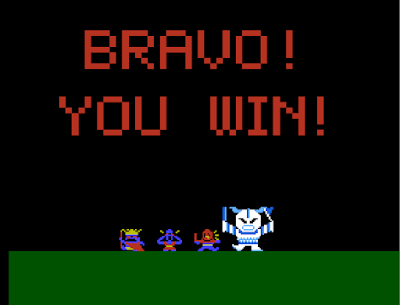 |
| An angry King Suren chases his enemies off screen. |
The game scores poorly as an RPG, getting only 15 points on the GIMLET, nothing rating higher than a 2, with 0s in economy and equipment. Nonetheless, it was enjoyable for a few hours as I tried to figure out the right strategies, watched the odometer count down my distance to Ogreth, and held my breath every time Suren entered combat. I lost 8 times–twice in the last 100 meters–and I suppose I would feel differently about the game if that had continued much longer.
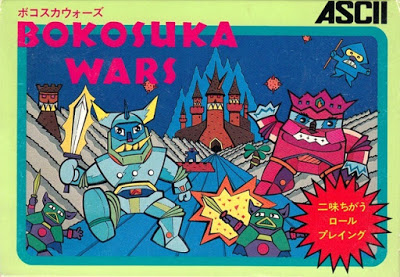 |
| The box captures the somewhat linear nature of the game. |
Given my generally positive feelings, I was surprised when I started doing my post-game research and saw Bokosuka Wars repeatedly referred to as the worst game ever made for the NES, with multiple sites calling it completely impossible. Granted, PC games were significantly ahead of the experience that Bokosuka Wars could provide, but even console-only players seem to love to trash this title. I suspect what’s happening here is that RPG-oriented players want their success determined by statistics that they can manage, and arcade-oriented players want their fate decided by their own dexterity. A game that’s so heavily based on random probability serves neither group. Nonetheless, I had fun with it. It showed me an approach to gameplay I haven’t experienced before. I wouldn’t want every game to take its mechanics from Bokosuka Wars, but as a one time experience, it was fine.
(Believe me, I appreciate the irony of me, who never heard of this game two weeks ago, who resisted the console sub-genre for a decade, suddenly mounting an impassioned defense of the first console RPG that I played.)
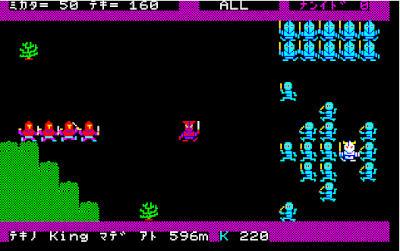 |
| The Sharp XI version starts the king with a large army. |
As poorly as the game was apparently received, it is credited in many sources in laying the foundations for the tactical RPG genre in Japan. I’ll reserve judgement on that until I actual play more tactical RPGs. In a funny footnote, Bokosuka Wars II was released for the PlayStation 4 in 2017. (There’s a so-called sequel called New Bokosuka Wars for the Sharp X1 alone in 1984, but I really think it’s just another version of the original game.) That gap of 33 years must be one of the longest between an original game and its sequel in gaming history, although Bethesda seems determined to beat it.
I’m disappointed that the game didn’t explain what bokosuka meant. Does anyone know? Googling provides mostly this game and a VR game called Bokosuka Girls. I’m trying to think what adjective could apply to both wars and buxom women and I’m coming up short.
Original URL: http://crpgaddict.blogspot.com/2019/07/game-334-bokosuka-wars-1983.html

